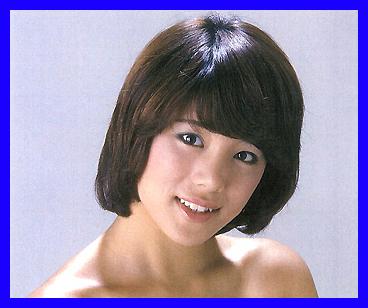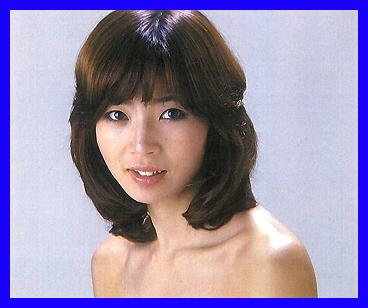The Pink Lady story began in March of 1976 when Mitsuyo Nemoto (now Tsukuda) and Keiko Masuda (now Kuwaki), a schoolgirl folk duo from Shizuoka Prefecture, the Japanese equivalent to Kansas passed the audition for Star Tanjo (Birth of a Star), an amateur talent show that groomed lucky contestants for TV stardom. Dressed in bib overalls, Mie and Kei possessed a fresh faced charm and energy that convinced the show's judges to give them a good grade and its producers to invite them back.
Six months later when the girls appeared on TV to promote their debut single, "Pepper Keibu" (Pepper Police Inspector), they had been completely transformed. Gone were the overalls, replaced by slinky, spangly mini-dresses. Gone too were the chords of their girlish folk tunes, replaced by catchy lyrics and infectious disco rhythms. Also as part of their new act were their dance routines, a combination of youthful vitality, sexy moves and near robotic precision, as repeated viewings on TV made clear the girls had been programmed to dance exactly the same way every time, as though they were executing a disco version of a karate kata.
To the Japanese audience, used to seeing female pop singers make archly stylized hand gestures to accompany their bubblegum melodies, the unmistakable booty shaking of Pink Lady, as the girls were christened hit like a visual bombshell. While they could get down and boogie just like Americans, adults were pleased to see that Mie and Kei were, deep down, good, clean, hardworking Japanese girls. Kids loved them too as children's books hit the market with step by step instructions on how to imitate the choreography of the latest Pink Lady song. Soon, even preschoolers were trying out the moves in front of the TV.
|
|
FROM LEFT TO RIGHT: Record sleeves for "Pepper Keibu", "SOS", "Southpaw" and "UFO"
"Pepper Keibu" climbed to number four on the charts and sold 605,000 copies. In December 1976, they released their second single, "SOS". It became their first number one record, selling 655,000 copies. And the Pink Lady boom was officially launched. Their moment at the very top was brief, from the summer of 1976 to the end of 1978, but while it lasted, Mie and Kei owned the airwaves like no other performers had in the medium's history. They not only appeared on every pop music and variety show to plug their latest hits, but contracted as commercial pitchwomen for eleven companies, a total seldom equaled or surpassed.
When an educational magazine for kids hired Mie and Kei as "image talents" (imeeji tarento or cover girls), it immediately surged to a sales lead of one hundred thousand copies over its rivals. An ice cream brand that had their picture on the package recorded a four fold gain in sales. When a shampoo maker used them in its ads, suddenly kids all over the country were demanding to have their hair washed with the Pink Lady brand. What you see below is but a mere sample of some of the products Mie and Kei pushed during their heyday as they seemed to be in every TV commercial in sight.
|
|
From radios to ramen noodles, dolls to shampoo, Mie and Kei pitched it all
As hit followed hit and the duo's popularity reached its peak in 1978, the industry paid its respects with awards, including the Japan Song Prize for "Southpaw" (whose choreography included pitching motions) and the Japan Record Prize for "UFO" (which was a great favorite with the grade school crowd). Also, Mie and Kei were busy expanding their professional range, having played their very first gig in the U.S. at the Tropicana Hotel in Las Vegas. Then, in December, they released their first movie, Pink Lady Katsudo Daishashin (The Big Picture of Pink Lady on the Go) and recorded their first English language single, "Love Showdown".
Toward the end of their miracle year, Mie and Kei were riding so high that they turned down an invitation to appear on Kohaku Uta Gassen (Red-and-White Song Contest, a long running and immensely popular TV talent show broadcast every New Year's Eve) in favor of a competing charity show on another network called Pink Lady Ase to Namida no Omisoka 150 Pun! (Pink Lady's 150 Minutes of Sweat and Tears on New Year's Eve!). In Japanese show business terms, this was the equivalent of passing on the Grammys to perform on a cable TV telethon in the same time slot.
That decision proved to be disastrous in the ratings as Kohaku was watched that night by a whopping 72.2 percent of the audience to only 8.2 percent for Pink Lady's special. Also, when the duo's managers told the media that they were inviting students from a school for the blind to the taping session, school officials publicly complained that they hadn't been consulted about the announcement. It looked as though Pink Lady were using blind kids to hype their TV show and, as a result, Mie and Kei's squeaky clean image received its first serious blemish.
As it turned out, the New Year's Eve fiasco signaled the beginning of the end. Pink Lady's first release of 1979, "Jipangu" only got as high as fourth, ending their impressive streak of number one hits. Their next record, "Pink Typhoon" was covered by the Village People but ran out of gas at number six and sold a disappointing 290,000 copies. Though their next single, "Nami Nori Pirates" (Surf Riding Pirates) used members of The Beach Boys as a back-up group, it stalled at number four. Ironically, as their fortunes declined in Japan, Mie and Kei looked for new opportunities abroad.
In the summer of 1979, the girls starred on a summer replacement show on NBC whose ratings sailed as high as 32 percent (See: Pink America). In June, they had their first worldwide release, "Kiss In The Dark" which got as high as 37th on the Billboard record charts (See: Pink Music). But, "KITD" vanished after only three weeks, and their TV show was gone by the spring. Back in Japan, Mie and Kei struggled for another year, but by then, they couldn't give their records away. In March of 1981, they held a farewell concert at Korakuen Stadium (Japan's largest outdoor stadium), then disbanded.
After it was all over, Kei told an interviewer that from the beginning, "I was very aware that we were a product." Mie simply said, "After we announced we were splitting up, I felt tremendously relieved." In 1982, Mie shed her Pink Lady image for good when she made a shocking comeback as the star of Call Girl, a movie about a woman who sells herself to save her former lover from a gang of Middle East terrorists. She used the professional name MIE, written in Roman capital letters, as though to remind fans of her brief moment of success while Kei, who planned to quit show business entirely made occasional TV appearances.
In 1988, Mie and Kei reunited for an appearance on Kohaku Uta Gassen, the show that had given Pink Lady its first serious setback and, the following year, had not invited them to appear, despite their still impressive string of hits. If Mie and Kei still had any hard feelings about those decade old wounds, they didn't show them. In the mid 90's, Pink Lady became a hot nostalgic item. Prices of Pink Lady posters, fanzines, and other memorabilia went through the roof, and sales of their albums began to perk up. Just like here in the States, nostalgia of any kind, including Pink Lady is just as popular as ever.
However, as it turns out, I'm happy to report that this is not the end of the story. In April of 1999, I discovered some Japanese based Pink Lady websites, all under the aegis of---get this---The Pink Lady Network Association of Japan (www.pinklady.org), or, PL-NET. One of these sites, which happens to be in English reported that Mie and Kei reunited in late 1996 and recorded "Pink Eyed Soul", their first new song (which the Ladies co-wrote) in 15 years. According to what I read there, Mie and Kei were out to show the new generation of pop stars how it's done! Way cool!
Following the popularity of "Pink Eyed Soul", attracting both new fans and bringing old fans back into the fold, Mie and Kei went on a whirlwind promotional tour and did concert appearances in 1997. Later that year, Mie married while she and Kei successfully transitioned from pop singers to actresses, remaining very much in the public eye. On New Year's Eve 2000, Mie and Kei performed on Kohaku, drawing in an astonsihing sixty percent of the viewing audience during their performance. Then, in June 2002, Kei wed an old sweetheart from her Pink Lady days. And still, their story is far from complete.
|
|





